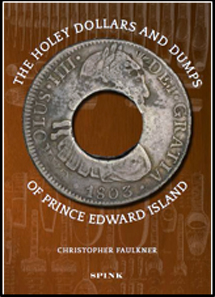October 18, 2012 – This is the first book-length study to be devoted to Canada’s most exotic and celebrated colonial-era coin, the Holey Dollar of Prince Edward Island and its accompanying Dump. The fruit of twenty years of research in international archives, libraries, and private and institutional collections, from as far afield as Charlottetown and Puerto Rico, Vancouver and London, this book uncovers the origins and history of a coin which has been shrouded in mystery for two hundred years.
Christopher Faulkner, The Holey Dollars and Dumps of Prince Edward Island, Spink, London, 2012. 400 pages. GBP 65.
The Prince Edward Island Holey Dollar is one of the most renowned Canadian colonial coins, arousing deep numismatic and historical interest. The Dollar and its Dump represent a unique instance in the whole of British North America of the cutting and countermarking of a coin so that its parts might pass as legal tender. Because they were made from Spanish-American Dollars, the most widely circulated coin of its day and a standard of value throughout the entire world, these coins have a legitimate place in many different sorts of collections: the Spanish American series; crown-sized coins of the world; cut and countermarked coins; emergency or proclamation coinage; semi-official colonial issues; and, finally, private merchants’ tokens. There is no other Canadian coin or token that can claim to be so many things to so many interests at once.
The book’s Introduction elaborates the monetary and commercial circumstances, as well as the political and economic conditions, which led to the initial production of this unusual coin in 1813 and to its eventual disappearance over the ensuing years. To that end, the book addresses a number of provocative questions. Who made the Holey Dollars and Dumps? How were they made? How long did they circulate? What could they buy? What were their precedents? Can we distinguish a Government issue Dollar or Dump from contemporary merchant counterfeits? What motivated the counterfeiters? In the course of addressing these questions, the author presents something of the texture of the places and peoples bound up with the Holey Dollar of PEI for the past two hundred years. The people that figure here include collectors and bystanders, merchants and government officials, and the places range from a Canadian homestead to an island in the Caribbean. An Appendix includes an original census of Charlottetown with heads of households for 1813.
About the Author
Christopher Faulkner is Distinguished Research Professor and Professor Emeritus at Carleton University, Ottawa, Canada, and a Fellow of the Canadian Numismatic Research Society. In the field of numismatics, his primary area of research interest is the pre-Confederation Canadian token coinage, and he has written a number of articles and book chapters on various aspects of the token coinage of the period.
The Holey Dollars and Dumps of Prince Edward Island is published by Spink, London, with the financial support of the J. Douglas Ferguson Historical Research Foundation.
For more information visit Spink’s website.
You can learn more about the J. Douglas Ferguson Foundation by clicking here.
Do you know what role the Holey Dollars played in Australian history? If you don’t you should not miss this article from our archive!




